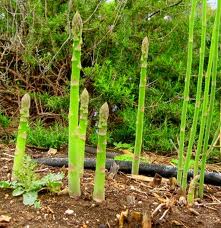
THE ASPARAGUS Asparagus are coming up now and they are delicious! I like to eat them raw right out of the garden. They are easy to care for and produce every year. It is a perennial vegetable rich in B vitamins, vitamin C, calcium, and iron. Asparagus is one of the first crops of spring harvest! They thrive in areas having winter ground freezes or dry seasons. The mild, wet regions of Florida and the Gulf Coast are about the only places where it’s difficult to grow.
Prepare an asparagus bed with care for they will occupy the same spot for 20 years or more. They will tolerate some shade, but full sun produces more vigorous plants and helps minimize disease. Asparagus does best in lighter soils that warm up quickly in spring and drain well; standing water will quickly rot the roots. Prepare a planting bed about 4 feet wide by removing all perennial weeds and roots and digging in plenty of aged manure or compost. Asparagus plants are monoecious— a plant is either male or female.
Some varieties of asparagus, such as ‘Jersey Knight’ and ‘Jersey Giant’ produce all male or primarily male plants—male plants yield more harvestable shoots because they don’t have to invest energy in producing seeds. Choose an all-male variety if high yield is your primary goal. If you like to experiment, grow an heirloom variety or a purple-stalked variety like ‘Purple Passion’. With an all-male variety, twenty-five plants are usually adequate for a household of four; plant double that amount for standard varieties. Starting asparagus from 1-year-old crowns gives you a year’s head start over seed-grown plants. Two-year-old crowns suffer more from transplant shock and won’t produce faster than 1-year-old crowns.
To plant asparagus crowns, dig trenches 12 inches wide and 6 inches deep (8 inches in sandy soil) down the center of the prepared bed. Soak the crowns in compost tea for 20 minutes before planting. Place the crowns in the trenches 1½ to 2 feet apart; top them with 2 to 3 inches of soil and two weeks later, add another inch or two of soil. Add soil periodically until soil is slightly mounded above the surface level to allow for settling.
